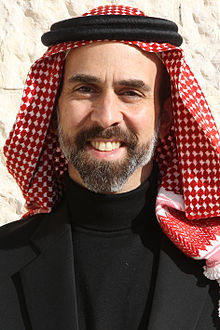Ghazi bin Muhammad
| Prince Ghazi bin Muhammad | |
|---|---|
 |
|
| Born |
15 October 1966 Amman, Jordan |
| Spouse | Princess Areej Ghazi |
| Issue | Princess Tasneem Prince Abdullah Princess Jennah Princess Salsabeel |
| House | Hashemite |
| Father | Prince Muhammad bin Talal |
| Mother | Firyal Irshaid |
Prince Ghazi bin Muhammad (born 15 October 1966) is a Jordanian prince, professor of philosophy, and a direct descendant of the Islamic prophet Muhammad. He is the son of Prince Muhammad bin Talal of Jordan and his first wife, Princess Firyal. He is a grandson of King Talal of Jordan and thus a first cousin of King Abdullah II and thirteenth in the line of succession to the Jordanian throne. He is well known for his religious initiatives, about which a book was published in 2013.
He attended Harrow School (1979–1984) for his 'O' and 'A' Levels.
He attended Princeton University: (1984–1988) receiving a BA in Comparative Literature (June 1988), Graduating with Highest Honours, Summa cum laude.
He received his PhD (Cantab.) in Modern and Medieval Languages and Literatures (July 1993) with a thesis titled, "What is Falling in Love?: A Study of the Literary Archetype of Love."
University of Cambridge (Trinity College): (1988–1989; 1990–1993)
He attended Al-Azhar University, College of Usul al-Din, Cairo (2007–2010) receiving his PhD ('Alimmayah) in Islamic Philosophy, awarded highest honors on January 16, 2010 with thesis title: Love in the Holy Qur'an.
Promoted to First Lieutenant (November 14, 1992). Commissioned as a Second Lieutenant (November 1989).
The site of baptism of Jesus had been known to be around the Jordan River, but no one knew exactly were. An abandoned site in Jordan overlooking the river, was heavily mined in 1967 due to an acquired front line position during the Six-Day War. In 1994 after the signing of the Israel–Jordan peace treaty, Prince Ghazi who is deeply interested in religious history, was searching the area after a monk convinced him to take a look around of what was thought to be the baptism site. When they found evidence of ruins, that was enough to encourage de-mining and further development. Soon afterwards, there were several archaeological digs, tourists influx and pilgrimage activity, and several papal and state visits. In July 2015, the site was designated as a UNESCO world heritage site and is now known as the most likely location for the baptism of Jesus by John the Baptist.
...
Wikipedia
